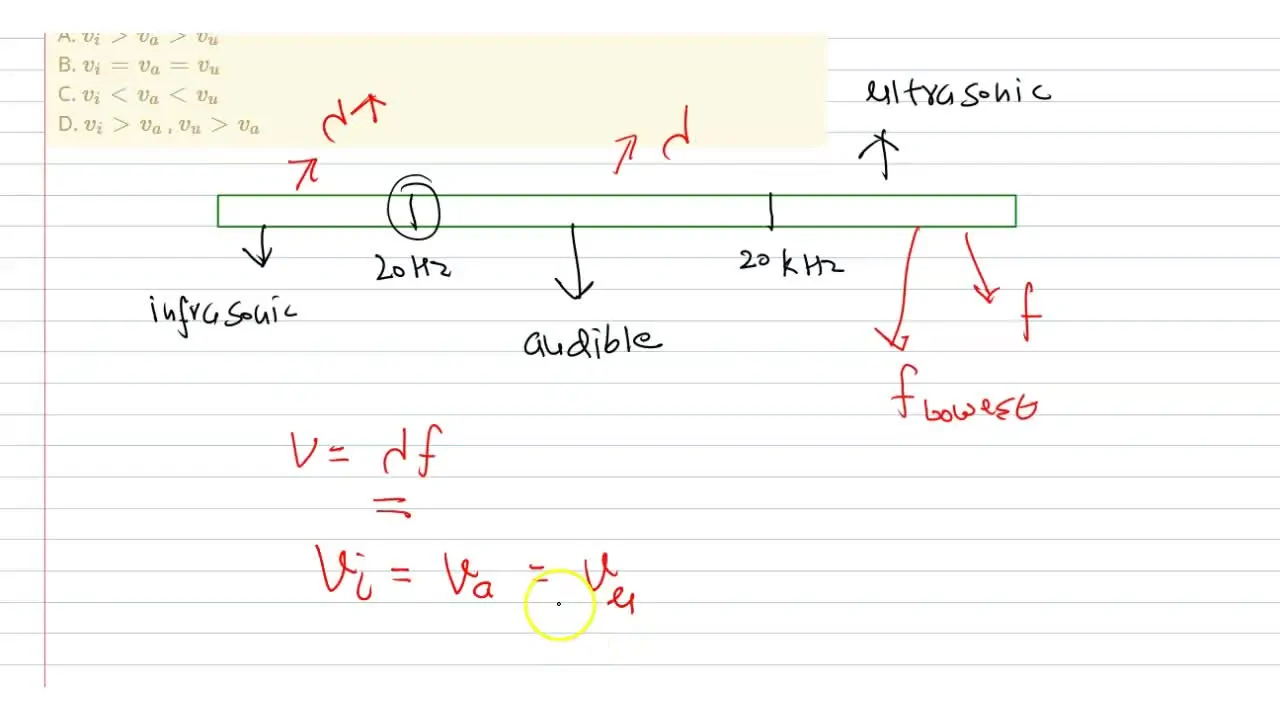Ultrasonic and Infrasonic Waves: The sound having frequency 20 Hz to 20 KHz is called audible sound Human ear cannot hear sound of frequencies lying outside this range. The limits of audibility of sound vary from individual. Generally the upper limit decreases with increase of age of individual, usually and people can not hear sound of frequency more than 15 kHz.
Sound of frequencies below 20 Hz are called infrasonics, while frequencies beyond 20 kHz are called ultrasonics. Ultrasonics can be heard by dogs, cat bats etc. Bats detect the path by means of ultrasonics. Ultrasonics can be used for diagnosis of tumour and other abnormalities within our body. This is known as ultrasonography. Ultrasonics are used to curve various diseases and to measure depth of oceans to detect submarines.
If speed of infrasonics, a audible and ultrasonics waves are vi, vaand vu then
A. vi>va>vu
B. vi=va=vu
C. vi<va<vu
D. vi>va , vu>va
vi>va>vu
vi=va=vu
vi<va<vu
vi>va , vu>va
The correct Answer is:B
Step by step video & image solution for Ultrasonic and Infrasonic Waves: The sound having frequency 20 Hz to 20 KHz is called audible sound Human ear cannot hear sound of frequencies lying outside this range. The limits of audibility of sound vary from individual. Generally the upper limit decreases with increase of age of individual, usually and people can not hear sound of frequency more than 15 kHz. Sound of frequencies below 20 Hz are called infrasonics, while frequencies beyond 20 kHz are called ultrasonics. Ultrasonics can be heard by dogs, cat bats etc. Bats detect the path by means of ultrasonics. Ultrasonics can be used for diagnosis of tumour and other abnormalities within our body. This is known as ultrasonography. Ultrasonics are used to curve various diseases and to measure depth of oceans to detect submarines. If speed of infrasonics, a audible and ultrasonics waves are v_(i), v_(a) and v_(u) then <BR><BR>A. v_(i) > v_(a) > v_(u)<BR>B. v_(i) = v_(a) = v_(u)<BR>C. v_(i) < v_(a) < v_(u)<BR>D. v_(i) > v_(a) , v_(u) > v_(a) by Physics experts to help you in doubts & scoring excellent marks in Class 12 exams.
Similar Questions
Ultrasonic and Infrasonic Waves: The sound having frequency 20 Hz to 20 KHz is called audible sound Human ear cannot hear sound of frequencies lying outside this range. The limits of audibility of sound vary from individual. Generally the upper limit decreases with increase of age of individual, usually and people can not hear sound of frequency more than 15 kHz.
Sound of frequencies below 20 Hz are called infrasonics, while frequencies beyond 20 kHz are called ultrasonics. Ultrasonics can be heard by dogs, cat bats etc. Bats detect the path by means of ultrasonics. Ultrasonics can be used for diagnosis of tumour and other abnormalities within our body. This is known as ultrasonography. Ultrasonics are used to curve various diseases and to measure depth of oceans to detect submarines.Ultrasonics are used for navigation by
View SolutionUltrasonic and Infrasonic Waves: The sound having frequency 20 Hz to 20 KHz is called audible sound Human ear cannot hear sound of frequencies lying outside this range. The limits of audibility of sound vary from individual. Generally the upper limit decreases with increase of age of individual, usually and people can not hear sound of frequency more than 15 kHz.
Sound of frequencies below 20 Hz are called infrasonics, while frequencies beyond 20 kHz are called ultrasonics. Ultrasonics can be heard by dogs, cat bats etc. Bats detect the path by means of ultrasonics. Ultrasonics can be used for diagnosis of tumour and other abnormalities within our body. This is known as ultrasonography. Ultrasonics are used to curve various diseases and to measure depth of oceans to detect submarines.
The waves produced by simple pendulum (having time period 2 seconds) are
A. infrasonic
B. audible
C. ultrasonic
D. none of theseView SolutionA man can hear the sound of frequency:
View SolutionWe can hear sounds of frequency in the range of ............
View SolutionName the sounds of the frequencies given below:
10 HzView SolutionName the sounds of the frequencies given below:
40 HzView SolutionA sound of single frequency is called a
View SolutionHuman beings can hear ultrasonic sound.
View SolutionName the sounds of the frequencies given below:
100 HzView SolutionName the sounds of the frequencies given below:
1000 HzView Solution


